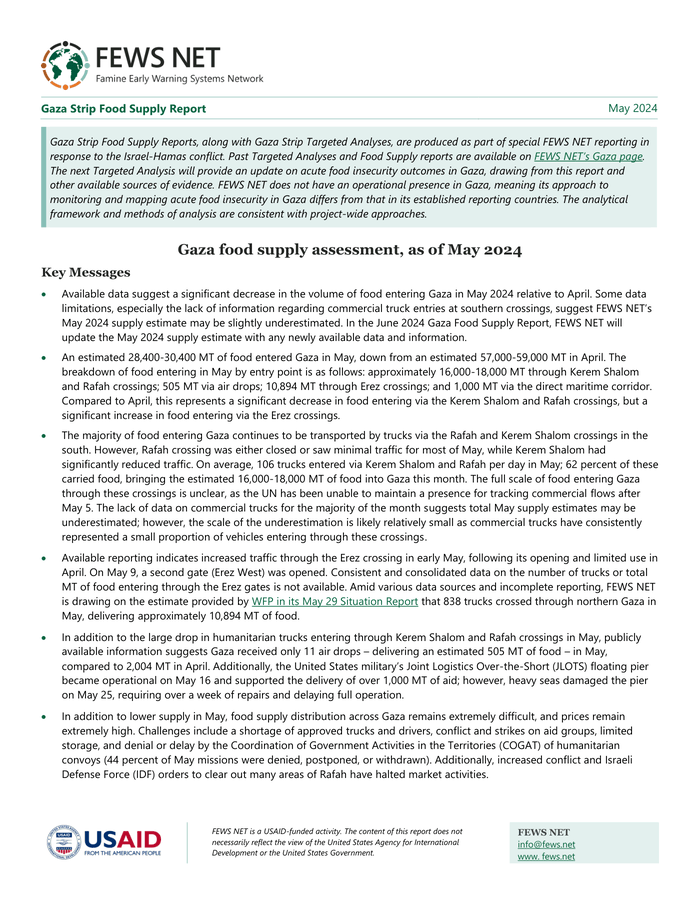Attachments
The Gaza Food Supply Report, along with a targeted analysis of the Gaza Strip, has been produced as part of FEWS NET’s special report responding to the Israel-Hamas conflict. Previous targeted analyses and food supply reports can be found on the FEWS NET Gaza page. The following targeted analysis provides an update on the consequences of acute food insecurity in Gaza from this report and other available sources of evidence. FEWS NET is not operationally based in Gaza, so FEWS’ approach to monitoring and mapping acute food insecurity in Gaza differs from that in existing reporting countries. The analytical framework and methodology are consistent with the overall project approach.
Gaza Food Supply Assessment as of May 2024
Key Messages
Available data indicates that the amount of food entering Gaza in May 2024 is significantly lower than in April. Due to some data limitations, particularly a lack of information on commercial truck entries into the southern checkpoints, FEWS NET’s May 2024 supply estimate may be a slight underestimate. In the June 2024 Gaza Food Supply Report, FEWS NET will use newly available data and information to update its May 2024 supply estimate.
An estimated 28,400-30,400 tons of food entered Gaza in May, down from an estimated 57,000-59,000 tons in April. Food arrivals in May were comprised of approximately 16,000-18,000 tons through the Kerem Shalom and Rafah checkpoints, 505 tons via airdrops, 10,894 tons through Erez checkpoint, and 1,000 tons via the direct maritime corridor. Compared to April, food arrivals through the Kerem Shalom and Rafah checkpoints have decreased significantly, while food arrivals through the Erez checkpoint have increased significantly.
The majority of food entering Gaza continues to be transported by truck through the Rafah and Kerem Shalom checkpoints in the south. However, the Rafah checkpoint was closed or had minimal traffic for much of May, while the Kerem Shalom checkpoint saw a significant reduction in traffic. An average of 106 trucks entered Gaza through the Kerem Shalom and Rafah checkpoints per day in May. Of these, 62% carried food, with an estimated 16,000-18,000 tonnes of food brought into Gaza this month. The full extent of food entering Gaza through these checkpoints is unknown, as the UN has not been able to maintain a presence there since May 5 to track commercial shipments. The absence of data on commercial trucks for most of the month may have resulted in an underestimate of the total supply estimate for May, but the magnitude of the underestimate is likely relatively small, as commercial trucks have consistently made up a small percentage of vehicles passing through these checkpoints.
According to available reports, the Erez crossing was opened in April with limited use before traffic increased in early May. A second gate (Erez West) was opened on May 9. Consistent, consolidated data on the number of trucks or total tonnage of food passing through the Erez Gate is not available. With varying data sources and incomplete reporting, FEWS NET relies on estimates provided by WFP in its May 29 situation report that 838 trucks passed through northern Gaza in May, carrying approximately 10,894 tons of food.
In addition to a significant decline in humanitarian trucks entering Gaza through the Kerem Shalom and Rafah checkpoints in May, publicly available information indicates that Gaza received only 11 airdrops in May delivering an estimated 505 tons of food, a significant decrease from the 2,004 tons received in April. Additionally, the U.S. military’s Joint Logistics Very Short Range (JLOTS) floating platform began operations on May 16 and supported the delivery of over 1,000 tons of aid, but heavy seas damaged the platform on May 25, requiring more than a week of repairs and delaying its full operation.
In addition to the reduction in supplies in May, distribution of food supplies across Gaza remains extremely difficult and prices remain extremely high. Challenges include a shortage of licensed trucks and drivers, fighting and attacks on aid groups, limited storage space, and refusal or delays of humanitarian convoys by the Coordination of Government Activities in the Territories (COGAT) (44 percent of missions in May were rejected, postponed or withdrawn). Additionally, escalating conflict and the Israel Defense Forces’ (IDF) orders to clear many areas of Rafah have brought market activity to a halt.


